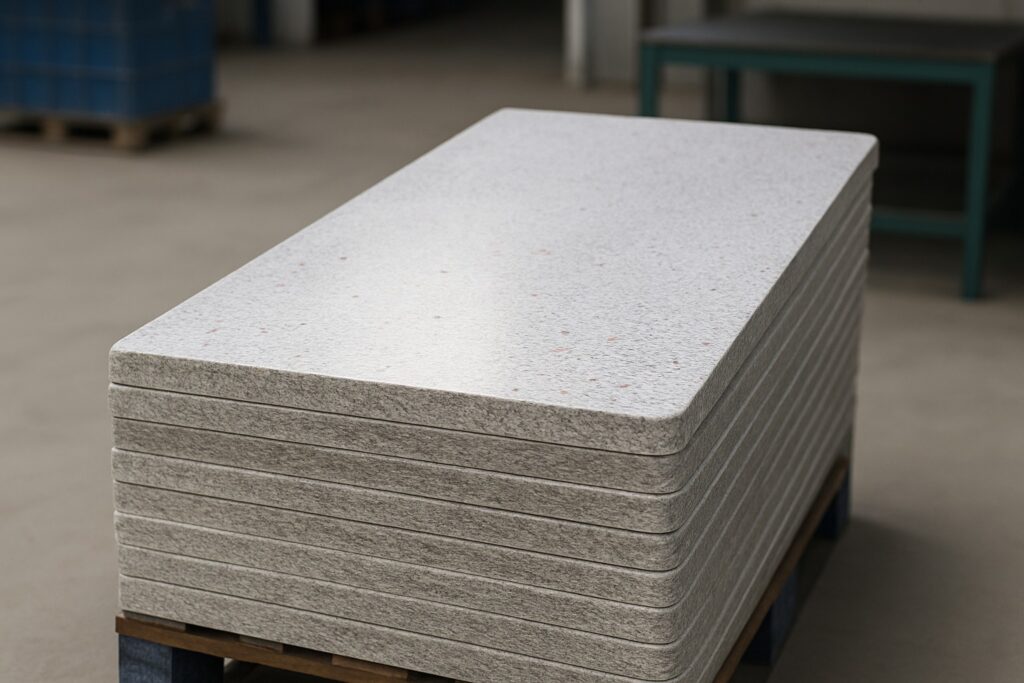Pallet boards may look like simple accessories on a construction site, but in India’s brick, block, and paver manufacturing industry, they play a far more significant role. The stability, durability, and dimensional accuracy of a pallet directly influence block quality, machine efficiency, and long-term operating costs.
However, the Indian market is crowded with different pallet options – wooden pallets, PVC sheets, recycled municipal plastic boards, and engineered composite pallets like Rajratan’s PAC® Pallet. Understanding how each is manufactured is essential for making an informed choice.
This feature breaks down the manufacturing behind each type – and why engineering, not appearance, determines performance.
1. Wooden Pallets: Traditional but Technically Limited
How They’re Made
Wooden pallets are manufactured by:
- Layering softwood or low-density hardwood
- Bonding them with resin
- Pressing under heat
- Applying moisture-resistant coatings
Where Manufacturing Fails
Wood is a natural, inconsistent material. Even when processed properly, it still:
- Absorbs water
- Warps under load
- Swells during monsoon
- Cracks under vibration
- Loses shape as the coating wears off
For India’s humid climate and high-vibration block plants, the manufacturing limitations of wood become very visible within months.
2. PVC Pallets: Smooth Surface, Weak Core
How They’re Made
PVC boards are extruded from polyvinyl chloride mixed with stabilizers and fillers, then laminated for surface finish.
Where Manufacturing Fails
PVC is a thermoplastic — it softens in heat.
This means in many Indian plants:
- Boards warp under sun exposure
- The lamination film peels
- Load-bearing capacity drops
- Edges deform during curing
PVC looks polished when new, but the manufacturing process limits its use for heavy-duty block or paver applications.
3. Recycled Municipal Plastic Boards: Cheap but Unstable
How They’re Made
These boards use municipal waste plastic — mixed polymers, paper fibres, moisture, and contaminants.
They are made by:
- Washing mixed waste
- Shredding
- Melting into sheets
- Applying a thin surface coating
Manufacturing Challenges
Because the feedstock is inconsistent, these boards often:
- Become brittle internally
- Carry moisture and impurities
- Crack during vibration
- Warp under heat
- Swell as paper fibres inside absorb water
Their manufacturing makes them cheap — but mechanically unreliable for any serious production setup.
4. Rajratan’s PAC® Pallet Boards
How They’re Made
High-quality composite boards are engineered using:
- Industrial-grade pre-consumer plastics (PP, LDPE, HDPE)
- Aluminium Oxide
- Fibres
- XLP metals
- (For heavy-duty variants) Steel tube frames
Unlike municipal plastic, these raw materials are pure, uniform, and mechanically strong resulting in a board designed specifically for production environments.
Rajratan’s PAC® Pallets are individually moulded and calibrated, not cut from sheets.
This ensures:
- Perfect flatness
- Uniform thickness
- Superior vibration transfer
- Higher compaction and consistent block height
Why Composite Manufacturing Works Better
- Zero water absorption
- Heat-resistant and UV-resistant
- No swelling or delamination
- High load-bearing capacity
- Long service life (10+ years in active production)
This is why engineered composites — especially those built using controlled formulations like PAC® technology — have become the top choice for modern Indian block plants.
Why the Manufacturing Method Dictates Performance
Different manufacturing processes → different outcomes:
Material Type | Manufacturing Strength | Weakness Origin |
Wooden | Simple, cost-effective | Natural variability, moisture absorption |
PVC | Smooth finish | Thermoplastic softening, low rigidity |
Recycled Plastic | Very low cost | Contaminated feedstock, inconsistent density |
Engineered Composite (PAC®) | Reinforced, calibrated, durable | Higher initial cost, but lowest lifecycle cost |
The difference becomes even more pronounced in India where:
- Summers reach 45–48°C
- Monsoon humidity is high
- Curing yards are outdoors
- Machines run high vibration cycles
- Handling conditions are rough
Materials built through controlled, engineered manufacturing simply perform better in these environments.
Where PAC® Pallets Fit Into This Landscape
Rajratan Industries pioneered PAC® technology to bridge the gap between durability, consistency, and real-world affordability.
Built from industrial-grade materials — not municipal waste — PAC® Pallets offer:
- Flatness engineered for block accuracy
- Stability under intense vibration
- Resistance to heat, UV, water, and deformation
- Long operational life (often 10+ years)
- A 40% buyback program supporting circular manufacturing
This combination of engineered materials + precision moulding creates one of the most reliable pallet solutions available to Indian block and paver manufacturers.
Conclusion: Quality Comes from Engineering, Not Appearance
Engineered composites PAC® Pallets from Rajratan — are designed to address all these limitations through controlled raw materials, structured manufacturing, and precision moulding.
When the manufacturing method is right, pallet boards stop being consumables — and become high-value, long-lived components of the production line.
- Phone: 0731 4045302
- Mobile: +91 96857 27927
- Email: info@rajratan.in

